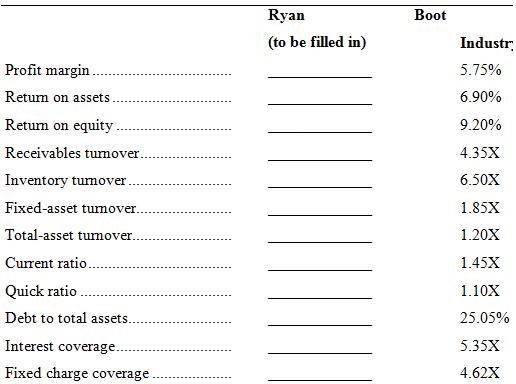Question: a. Analyze Ryan Boot Company, using ratio analysis. Compute the ratios on the prior page for Ryan and compare them to the industry data that
a. Analyze Ryan Boot Company, using ratio analysis. Compute the ratios on the prior page for Ryan and compare them to the industry data that is given. Discuss the weak points, strong points, and what you think should be done to improve the company’s performance.
b. In your analysis, calculate the overall break-even point in sales dollars and the cash break-even point. Also compute the degree of operating leverage, degree of financial leverage, and degree of combined leverage. (Use footnote 2 for DOL and footnote 3 in the chapter for DCL.)
c. Use the information in parts a and b to discuss the risk associated with this company. Given the risk, decide whether a bank should loan funds to Ryan Boot.
Ryan Boot Company is trying to plan the funds needed for 2014. The management anticipates an increase in sales of 20 percent, which can be absorbed without increasing fixed assets.
d. What would be Ryan’s needs for external funds based on the current balance sheet? Compute RNF (required new funds). Notes payable (current) and bonds are not part of the liability calculation.
e. What would be the required new funds if the company brings its ratios into line with the industry average during 2014? Specifically examine receivables turnover, inventory turnover, and the profit margin. Use the new values to recompute the factors in RNF (assume liabilities stay the same).
f. Do not calculate, only comment on these questions. How would required new funds change if the company:
(1) Were at full capacity?
(2) Raised the dividend payout ratio?
(3) Suffered a decreased growth in sales?
(4) Faced an accelerated inflation rate?

Income Statement—2013 | |
Sates (credit)........................................................................... | $7,000,000 |
Fixed costs*............................................................................ | 2,100,000 |
Variable costs (0.60)............................................................... | 4,200,000 |
Earnings before interest and taxes.......................................... | 700,000 |
Less: Interest........................................................................ | 250,000 |
Earnings before taxes.............................................................. | 450,000 |
Less: Taxes @ 35%.............................................................. | 157,500 |
Earnings after taxes................................................................. | $ 292,500 |
Dividends (40% payout)...................................................... | 117,000 |
Increased retained earnings..................................................... | $ 175,500 |
*Fixed costs include (a) lease expense of $200,000 and (b) depreciation of $500,000.
| |
RYAN BOOT COMPANY Balance Sheet December 31, 2013 Assets Cash Marketable securities. Accounts receivable Inventory Gross plant and equipment 6,000,00 Liabilities and Stockholders Equity Accounts pavable Accrued expense Notes payable (current. Bonds (10%) Common stock (1.7 million 1,700,000 S 50,000 80,0p0 $2,200,000 150,000 .400.000 2,500,000 3,000,000 1000,000 shares, par value S1) Retained earnings Totalliabilities ess Accumulated depreciation. 2.000,000 1,180,000 and $8,130,000 Total assets S8,130,000 stockholders equity Rvan (to be filled in) Profit margin Retum on assets Returm on equity Receivables tumover Inventory turmove Fixed-asset turmover Total-asset turmover Current ratio Quick ratio Debt to total assets Interest coverage Fixed charge coverage Industr, 5.75% 6.90% 9.20% 4.35X 6.50X 1.85X 1.20X 1.45X 1.10X 25.05% 5.35X 4.62X
Step by Step Solution
3.35 Rating (164 Votes )
There are 3 Steps involved in it
Ryan Boot Company a Ratio analysis Ryan Industry Profit margin 2925007000000 418 575 Return on assets 2925008130000 360 690 Return on equity 2925002880000 1016 920 Receivable turnover 70000003000000 2... View full answer

Get step-by-step solutions from verified subject matter experts
Document Format (1 attachment)
341-B-F-F-O-A (125).docx
120 KBs Word File



